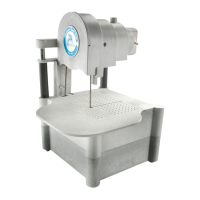the paper pattern to the glass with double sided tape.
• Copy your pattern onto clear plastic (use Overhead Transparency Sheets - available at your copy
center or ofce supply store). Apply the plastic pattern to the glass with double-sided tape.
If you are using either of the last two techniques, it is recommended that you make separate patterns
for each piece, rather than planning to reuse pattern pieces. It is often convenient to leave the
pattern on the piece for easy identication later, particularly in projects involving small pieces, such
as lamp shades.
You will nd that in some cases, such as lamp shades, you will be able to place large sections of
the pattern on the glass and cut several pieces at once. The blade will make a slot in the glass that is
just about the same width as two pieces of foil, so you will only have to cut down the center of the
pattern line to achieve a perfect t.
Stacking Glass~
It is possible to cut multiple pieces of glass at the same time, however it is a frustrating process
since it is difcult to hold the various pieces together while cutting. If you wish to try it, there are
several ways to hold the glass that are at least limitedly successful:
• Double-sided indoor-outdoor carpet tape.
• Wax.
• Duct tape or similar.
The tapes and wax will tend to “gum up” the blade, but a few cuts through single pieces of glass
should remove any remaining tape residue. The pieces should be separated soon after cutting
because some tape bonds will continue to strengthen if left in place.
Cutting Glass~
When cutting, push your work with only a moderate pressure. Very heavy pressure will not result
in faster cutting, and may bend the blade. When cutting curves, use only a light pressure and let the
blade do the work. Aggressive pressure against the blade when cutting curves causes rapid wear to
the back of the blade. Do not force the blade to follow a pattern, but rather guide the work through
the blade. This will insure you of the longest possible blade life. When backing out of a slot, move
the work gently to avoid pulling the blade off the wheel.
It is normal for a blade to cut more slowly as it wears. Some materials, such as lead crystal, load the
blade and cutting action slows signicantly after a time. Good cutting action will be immediately
restored with only a little cutting into a piece of clear window glass, silicon carbide, or a brick.
Cutting Other Materials~
The diamond blade on your band saw is useful for cutting a variety of hard materials. Stone, tile,
ceramics and similar materials can be cut as easily as glass. The speed at which the saw cuts will be
determined by the thickness and the hardness of the material being cut. Harder materials will wear
the blade faster. Metals are too soft to be cut by a diamond blade and will gum up the blade.
You can incorporate gemstone material such as translucent Jade or Agate into your stained glass

